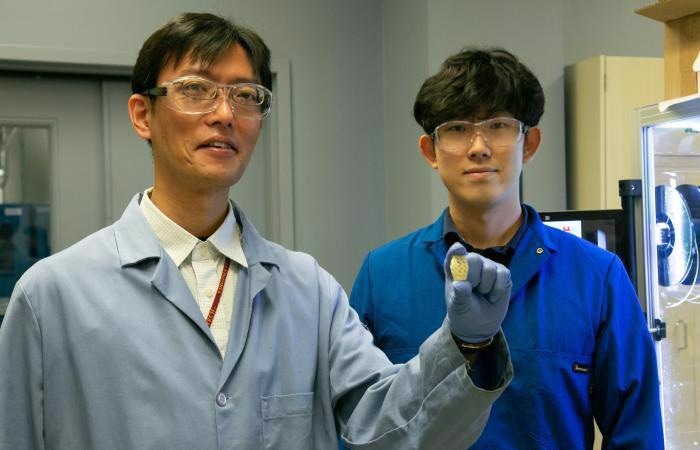At the Department of Energy’s Oak Ridge National Laboratory (ORNL), scientists have come up with an upcycling method that adds value to rejected plastics for reuse in additive manufacturing, or so-called 3D printing.
 ORNL polymer scientists Tomonori Saito, left, and Sungjin Kim upcycled waste plastic to create a stronger, tougher, solvent-resistant material for new additive manufacturing applications. Image Credit: Genevieve Martin/ORNL, US Department of Energy.
ORNL polymer scientists Tomonori Saito, left, and Sungjin Kim upcycled waste plastic to create a stronger, tougher, solvent-resistant material for new additive manufacturing applications. Image Credit: Genevieve Martin/ORNL, US Department of Energy.
The easily adaptable and scalable technique initiates a closed-loop plan that could decrease plastic waste and cut carbon emissions related to plastic production throughout the world.
The study outcomes reported in the journal Science Advances describe the simple process for upcycling a commodity plastic into the strongest material that is consistent with industry 3D-printing techniques.
The research team improved acrylonitrile butadiene styrene, or ABS, a famous thermoplastic found in daily objects varying from auto parts to tennis balls to LEGO blocks. ABS is a well-known feedstock for fused filament fabrication or FFF. It is one of the most extensively utilized 3D printing techniques.
The upcycled version promotes improved toughness, strength and chemical resistance, thereby making it appealing for FFF to fulfill new and greater performance applications that are not possible with standard ABS.
Polymer upcycling plays a crucial role in fulfilling the increasing difficulty of plastic waste accumulation throughout the world. Around 400 million tons of plastic waste has been produced annually, mostly as single-use items that end up in landfills or the surrounding. Around the world, less than 10% of plastic waste is recycled.
We will need fundamental discoveries to overcome the challenges of increased costs and deteriorating material properties associated with recycling. Our goal was to develop an easily adaptable strategy that reuses plastic waste to create a more valuable material instead of generating fresh plastic.
Tomonori Saito, Study Lead Author, Chemical Sciences Division, Oak Ridge National Laboratory
The group focussed on additive manufacturing, which is highly resource-efficient compared to traditional manufacturing and could obtain beneficial and complicated 3D structures that would be hard to produce by employing the process of casting or molding. FFF creates the biggest share of this industry at almost 70% of the global market.
“Developing new, recyclable materials with superior properties for FFF creates opportunities to make a big impact on plastic production and expand additive manufacturing capabilities that have the potential to reduce our carbon footprint,” stated ORNL’s Sungjin Kim.
FFF printing needs materials that can be ejected, or pushed, via a heated nozzle to develop the threads of 3D structures, constructed layer by layer, like coiling a rope. As a thermoplastic material that reacts to heat, ABS functions well for the process as it can easily flow and stiffen quickly into tough and strong structures.
But there are innate weaknesses in the approach the threads pile up and bind together in a collective manner. Coming up with new feedstocks with excellent properties could progress high-performance applications for FFF. However, this has been hard to design.
The team employed “click” chemistry to transform the chemical makeup of ABS into a vitrimer. A vitrimer is a kind of polymer that integrates the recyclability and processability of thermoplastics with the excellent mechanochemical properties of thermosets, like epoxy, which is normally not compatible with FFF.
The synthesis utilizes extensively available medical compounds that are blended in a single step under mild conditions. It is then cured with heat.
The outcomes display that upcycled ABS obtained around double the strength and toughness of standard ABS, with improved solvent resistance.
Scientists illustrated the outstanding compressive strength of the material along with complex 3D-printed geometric structures modeled on beetle wings.
Solvent resistance has added value because it allows us to easily separate the modified ABS from mixed, unsorted plastic waste commonly encountered in recycling scenarios.
Tomonori Saito, Study Lead Author, Chemical Sciences Division, Oak Ridge National Laboratory
Mixed plastic waste in several solvents was dissolved by the researchers, and in every experiment, upcycled ABS retained its structure, while all other plastics such as ABS dissolved entirely.
Kim stated, “The approach is extremely versatile. Recovered upcycled ABS can be reused again and again for FFF with minimal loss of properties. It can also be combined with mixed and standard ABS, and directly printed as a blend.”
The multi-pathway method allows both recycling and upcycling of integrated ABS waste consisting of any combination of normal, upcycled, or mixed ABS. All are consistent with FFF and do not have to be isolated before reprinting. However, isolation could easily be carried out to provide a selection of beneficial materials for wide manufacturing applications.
This effort demonstrates a closed-loop for manufacturing plastic items, potentially with higher value and performance, using only existing plastic waste in one of the most accessible areas of additive manufacturing.
Tomonori Saito, Study Lead Author, Chemical Sciences Division, Oak Ridge National Laboratory
The study was financially supported by ORNL’s Laboratory Directed Research and Development Program and the Office of Science.
Journal Reference:
Kim, S., et al. (2022) Closed-loop additive manufacturing of upcycled commodity plastic through dynamic cross-linking. Science Advances. doi.org/10.1126/sciadv.abn6006.